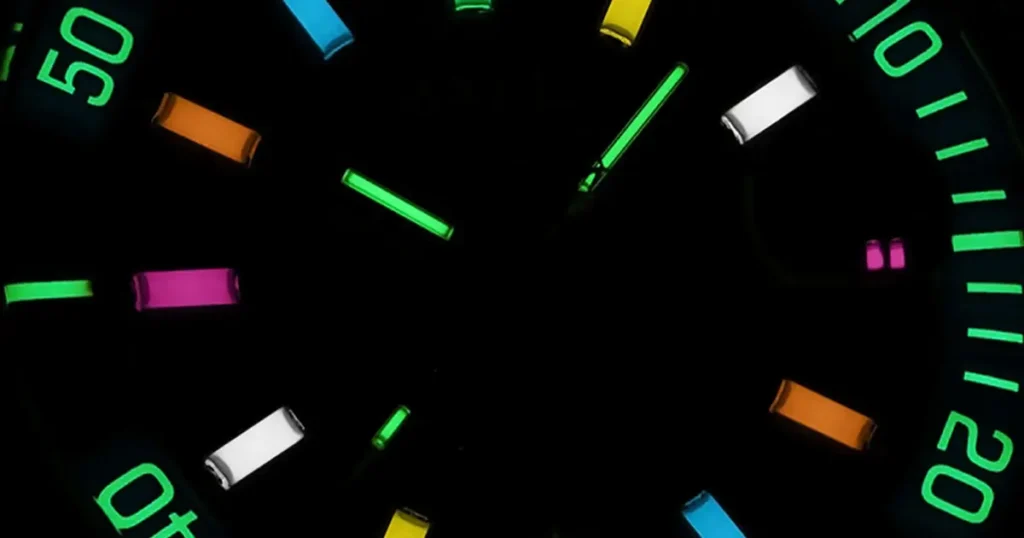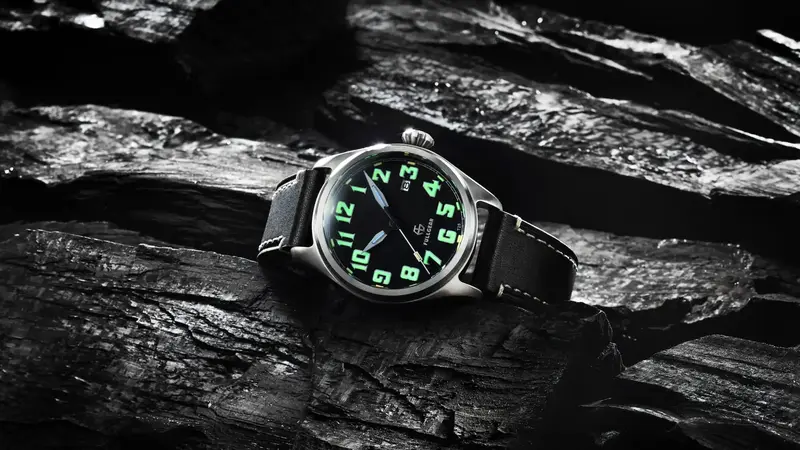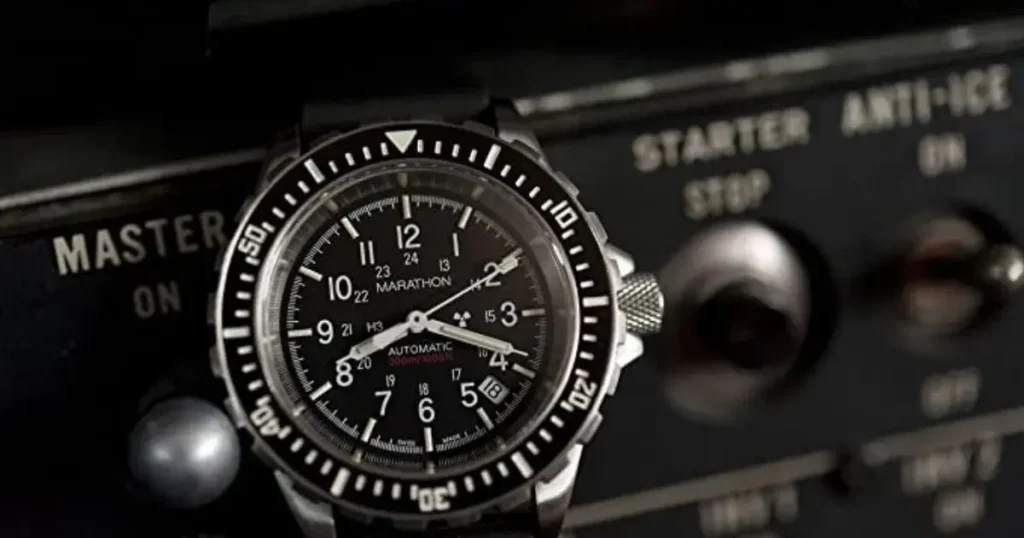Tritium watches are timepieces that glow in the dark using radioactive hydrogen gas. This illumination doesn’t require exposure to light or batteries.
Tritium, a radioactive isotope of hydrogen, is the cornerstone of these watches, providing users with reliable luminosity for easy night-time viewing. The gas is safely contained in tiny, sealed glass tubes that line the watch dials and hands. This self-powered lighting technology makes tritium watches especially popular among military personnel, outdoor enthusiasts, and anyone who needs to tell the time in low-light conditions.
With their robust and long-lasting glow, these watches offer convenience and functionality, making them a top choice for durability and performance in challenging environments. Their use of tritium ensures that the watch face remains visible for many years without any additional power source.
Table of Contents
The Science Behind Tritium Illumination
Imagine your watch glowing brightly without a push of a button. This magic comes from a special element called tritium. Tritium illumination makes it easy to read the time in the dark. Now, let’s dive into how tritium lights up watch dials.
Glowing Mechanism Of Tritium

Tritium is a radioactive form of hydrogen. It lights up when its electrons react with a substance called phosphor. This reaction creates a steady glow. The process, known as radioluminescence, doesn’t need any battery or sunlight to work.
- Safe amounts of tritium are used in watches.
- The tritium gas is sealed in tiny glass tubes.
- These tubes are placed on the watch dial and hands.
- The glow lasts for many years.
Pros And Cons Of Tritium In Watches
Pros
- Constant Glow: Visibility in complete darkness.
- Long-Lasting: Can glow for up to 25 years.
- Reliable: There is no need for an external light charge.
- Durable: Not affected by water or most chemicals.
Cons
- Radioactivity: Although very low, it is still radioactive.
- Decline Over Time: The brightness diminishes.
- Cost: Slightly more expensive due to the material.
- Replacement: Can’t be recharged; requires complete replacement.
History Of Tritium Use In Timepieces
The ‘History of Tritium Use in Timepieces’ marks an intriguing chapter in history. In the race to create the perfect luminescent watch, tritium has played a pivotal role. Timepiece enthusiasts and geeks alike appreciate the glowing tale of tritium’s rise. Let’s delve into timepiece luminescence history and uncover tritium’s transformative journey.
Early Adoption Of Tritium
Early wristwatches sought visibility in low light. Tritium, a radioactive isotope of hydrogen, emerged as a solution. Introduced in the 1960s, tritium paint replaced radium. It made watch dials readable in the dark. Tritium’s lower radioactivity extended its use. Watchmakers globally adopted this technology.
Evolution Of Radioluminescence In Watches

The birth of radioluminescence revolutionized timekeeping. Tritium’s application in watches quickly evolved. Tritium tubes replaced paint, boosting brightness and lifespan. These tubes, often called “gaseous tritium light sources,” or GTLS, offer watch buyers a glow lasting over a decade.
Safety advancements accompanied the glow’s evolution. Certification standards like T25 and T100 now mark tritium-based watches. They indicate contained tritium levels. Manufacturing processes improved to ensure users’ and workers’ safety. Tritium watches thus became famous for their longevity and reliability.
Comparing Tritium With Traditional Lume

Have you ever glanced at your watch in the dark, only to find the faint glow almost gone? Watches with glowing dials have two main types of luminescence: traditional phosphorescent materials and tritium-based illumination. Let’s dive into the glow and uncover the differences between tritium and traditional watch lumes.
Tritium Vs Phosphorescent Materials
Watch enthusiasts often talk about the luminosity of their timepieces. Traditional phosphorescent lume needs light to charge. In contrast, tritium lume shines steadily.
| Feature | Tritium | Phosphorescent |
| Brightness | Constant | Dim over time |
| Charging | Not needed | Requires light |
| Lifespan | Up to 25 years | Several hours |
| Material | Radioluminescent | Non-radioactive |
In this table, tritium watches outshine their phosphorescent counterparts without needing external light sources.
Why Some Manufacturers Prefer Tritium
Reliability in darkness and longevity make tritium a sought-after material for watchmakers. Reasons include:
- Readability: Tritium provides an unwavering glow.
- Maintenance-Free – No need to ‘charge’ the lume under a light.
- Consistent Performance: Works in all conditions without fading.
- Safety: Sealed within the watch, it’s perfectly safe for users.
For watchmakers whose priority is peak performance in low-light conditions, tritium proves ideal.
Safety Concerns With Tritium Watches
Tritium watches shine with a special light, thanks to a substance called tritium. These timepieces offer visibility in the dark without the need for an external light source. However, certain questions arise around their safety. This section will delve into concerns regarding both health and the environment.
Health And Environmental Risks
At the core of tritium watches are tiny glass tubes containing tritium gas. This gas emits a steady glow, enabling the watch face and hands to be seen in the dark. Tritium is a weak radioactive isotope, leading to worries about its potential impact.
- Direct exposure to broken tubes can be harmful.
- Tritium can be hazardous if ingested.
- The risk is minimal when tritium is sealed correctly within the watch.
Tritium has a half-life of about 12.3 years. As it decays, its radioactivity diminishes. Even so, concerns about its long-term environmental effect remain. A tritium watch thrown away improperly might pose a threat to the environment.
Regulations Governing Tritium In Watches

Due to its radioactive nature, tritium use is tightly controlled. Watchmakers must adhere to strict standards.
| Regulatory Body | Role |
| Nuclear Regulatory Commission (NRC) | Oversees tritium use in the United States. |
| International Atomic Energy Agency (IAEA) | Sets guidelines for member countries. |
Manufacturers must follow these guidelines and implement safety measures. This ensures that tritium watches remain within safe radiation limits for users. Wearers are largely shielded from risk if the watch remains intact.
Watches containing tritium must be labeled accordingly. They must come with instructions that explain the proper disposal methods to prevent environmental damage.
Top Tritium Watch Brands And Models
If you’re in search of a watch that offers unbeatable nighttime visibility, Tritium timepieces are the way to go. These watches are not only reliable but also come with self-powered illumination, thanks to the tritium gas encapsulated in tiny tubes on their dials and hands. This means they glow continuously without the need for charging by light. Let’s dive into the world of top-tier Tritium watch brands and their standout models.
Leading Innovators Of Tritium Timepieces
Certain brands stand tall in the realm of titanium watches, known for their quality and innovation. Let’s look at some pioneers:
- Luminox is renowned for its seal-approved durability and exceptional tritium illumination.
- Ball Watch Company: Blending luxury with practical Tritium lighting, Ball watches are a top choice.
- Traser: Originators of the Tritium watch, Traser maintains a coveted spot in the market.
- Marathon: offering military-grade toughness paired with clear tritium-based nighttime visibility.
- MTM Special Ops: Combining Tactical Functionality with Tritium Technology for Adventure Enthusiasts.
Review Of Popular Tritium Watch Models
Those seeking the best models that glow in the dark can refer to this handy guide:
| Brand | Model | Features |
| Luminox | Navy Seal | Rugged construction, water-resistant, signature blue illumination |
| Ball Watch Company | Engineer Hydrocarbon | Anti-magnetic, shock-resistant, and cold-temperature endurance |
| Traser | P6600 | Double-case construction, scratch-resistant sapphire crystal, enduring glow |
| Marathon | WW194013 | High-torque movement, government-specified design, chemical resistance |
| MTM Special Ops | Hypertec | Battle-ready materials, variety of finish options, customizable dial colors |
Whether you want a watch for outdoor adventures, a tactical mission, or daily wear, Tritium watches perfectly match reliability with visibility. Explore these brands and models to find a trusty companion that shines in the dark.
How Tritium Watches Work In Different Environments
Tritium watches are known for their reliability in various conditions. The secret lies in the tiny tubes placed on the watch’s dial and hands. These tubes contain tritium gas that glows without external light or batteries. This persistent luminescence makes them a top pick for many enthusiasts.
Performance Underwater
Tritium illuminates regardless of surroundings. Divers can easily read their watch deep under the sea. No light sources needed, as the tritium gas provides consistent visibility. Durable seals keep the tritium tubes secure from water ingress.
- Water pressure doesn’t affect tritium’s glow.
- Clear visibility in murky underwater environments.
- Long-lasting luminescence for extended dives.
Visibility In Varying Light Conditions

Tritium watches excel in environments with changing light conditions. Whether in bright sunlight or on a dark night, the tritium tubes shine steadily. There is no need for ‘charging’ from light; the glow is self-sustaining. Perfect for transitions between environments.
| Environment | Performance |
| Full Sunlight | Steady visibility without glare |
| Twilight | Enhanced readability |
| Complete Darkness | Optimal luminescence |
Maintenance And Care For Tritium Watches
Keeping your tritium watch in top condition demands attention. Proper maintenance ensures lasting glow and precision. Learn tips to extend its lifespan and when to service or replace parts. Let’s dive into the essentials of caring for these unique timepieces.
Extending The Lifespan Of Tritium Illumination
Tritium illumination is what makes these watches glow. The small, radiant tubes contain tritium gas that lights up your watch’s face. Here’s how to make the glow last:
- Avoid harsh chemicals. Keep your watch away from cleaning agents and solvents.
- Limit exposure to extreme conditions. Don’t wear your watch in conditions that are too hot, cold, or under high pressure.
- Stick to soft cloths for cleaning. Wipe your watch with a soft, dry cloth to keep it free from dust and moisture.
Servicing And Replacement Tips
Even with care, your watch may need servicing. Follow these tips to ensure your watch remains dependable:
- Regular Service. Have your watch checked by a professional every 3–5 years.
- Water Resistance Tests. If your watch is water-resistant, test it yearly. This prevents moisture from affecting the tritium.
- Replace When Dim. While tritium lasts up to 20 years, get it replaced if it dims earlier.
Remember, expert handling during servicing can protect the tritium tubes and maintain the watch’s integrity. Always turn to a certified service center for replacements.
Future Developments In Tritium Watch Technology
As the night sky twinkles with stars, tritium watch technology promises to light up our wrists with equal brilliance. This luminous innovation allows timepieces to glow in the dark, offering readability in low-light conditions. The merge of functionality and style makes them a favorite among watch enthusiasts. With advancements in science and design, the future of tritium watches looks brighter than ever.
Innovations On The Horizon
The watch industry is eagerly anticipating the next wave of tritium technology. The upgrades will likely bring enhanced brightness and longer-lasting luminescence. With these improvements, checking the time becomes effortless, even in pitch darkness.
- Increased efficiency in tritium gas tubes.
- New tritium compounds that shine brighter and longer.
- Greener manufacturing processes, yielding eco-friendly watches.
These innovations not only aim to refine the visual appeal but also make tritium watches more accessible.
The Impact Of Advancements In Watch Illumination
The glow from a small watch makes big waves in the world of gadgets. Improved tritium illumination pushes the boundaries of visibility and style. It turns simple timepieces into vital tools for professionals like divers and military personnel.
| Feature | Impact |
| Sharper visibility | Quick, clear reading at a glance. |
| Better longevity | Reliable glow for many years without fade. |
| Eco-friendly materials | Reduction in environmental impact. |
Moreover, these advancements don’t only serve function; they expand the aesthetic potential of watches. We anticipate various designs blossoming from new tritium concoctions. They are likely to offer a spectrum of colors and intensities for individual preferences.
Frequently Asked Questions For Tritium Watches
Why Was Tritium Banned In Watches?
Tritium was banned in watches due to its radioactive properties and potential health risks. The watch industry now uses safer luminous materials.
Is it safe to wear a titanium watch?
Yes, wearing a tritium watch is safe. The radioactive material is securely contained and emits very low levels of radiation, posing minimal risk.
Are tritium watches worth it?
Tritium watches are valuable for their long-lasting luminescence, durability, and low maintenance. Ideal for those needing reliable visibility in dark environments.
Is tritium still used in watch dials?
Yes, tritium is still used in some watch dials for luminescence, but its use has become less common due to alternative materials.
What are tritium watches?
Tritium watches utilize radioactive hydrogen gas to illuminate watch dials and hands, ensuring visibility in low-light conditions without needing exposure to light prior.
How do tritium watches work?
Tritium emits electrons through beta decay, which causes the watch’s phosphorescent material to glow, making the watch’s face and hands visible in the dark.
Are tritium watches safe to wear?
Yes, tritium watches are considered safe as the tritium gas is sealed in tiny glass tubes, preventing direct contact with wearers and containing its low radiation levels.
Can tritium watches last a lifetime?
Tritium in watches has a half-life of approximately 12.3 years, decreasing in brightness over time, so while durable, the luminosity won’t last a lifetime.
Do tritium watches require charging?
No, tritium watches do not require charging from light sources, as the tritium provides constant luminescence through its self-powered illumination technology.
Why Choose a Tritium Watch Over Traditional Ones?
Tritium watches offer superior nighttime visibility and don’t rely on external light to charge, making them a reliable choice for low-light environments.
Conclusion
Tritium watches offer unmatched visibility in low-light conditions, merging practicality with style. Perfect for those seeking reliability and fine craftsmanship, these timepieces stand out in the watch market. Embrace the glow of innovation on your wrist; consider a tritium watch as your next timeless investment.









Leave a Reply